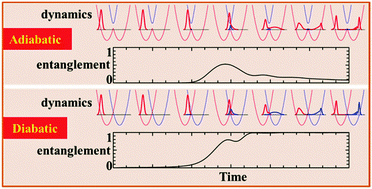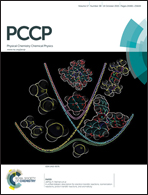Electron–vibration entanglement in the Born–Oppenheimer description of chemical reactions and spectroscopy
Abstract
Entanglement is sometimes regarded as the quintessential measure of the quantum nature of a system and its significance for the understanding of coupled electronic and vibrational motions in molecules has been conjectured. Previously, we considered the entanglement developed in a spatially localized diabatic basis representation of the electronic states, considering design rules for qubits in a low-temperature chemical quantum computer. We extend this to consider the entanglement developed during high-energy processes. We also consider the entanglement developed using adiabatic electronic basis, providing a novel way for interpreting effects of the breakdown of the Born–Oppenheimer (BO) approximation. We consider: (i) BO entanglement in the ground-state wavefunction relevant to equilibrium thermodynamics, (ii) BO entanglement associated with low-energy wavefunctions relevant to infrared and tunneling spectroscopies, (iii) BO entanglement in high-energy eigenfunctions relevant to chemical reaction processes, and (iv) BO entanglement developed during reactive wavepacket dynamics. A two-state single-mode diabatic model descriptive of a wide range of chemical phenomena is used for this purpose. The entanglement developed by BO breakdown correlates simply with the diameter of the cusp introduced by the BO approximation, and a hierarchy appears between the various BO-breakdown correction terms, with the first-derivative correction being more important than the second-derivative correction which is more important than the diagonal correction. This simplicity is in contrast to the complexity of BO-breakdown effects on thermodynamic, spectroscopic, and kinetic properties. Further, processes poorly treated at the BO level that appear adequately treated using the Born–Huang adiabatic approximation are found to have properties that can only be described using a non-adiabatic description. For the entanglement developed between diabatic electronic states and the nuclear motion, qualitatively differently behavior is found compared to traditional properties of the density matrix and hence entanglement provides new information about system properties. For chemical reactions, this type of entanglement simply builds up as the transition-state region is crossed. It is robust to small changes in parameter values and is therefore more attractive for making quantum qubits than is the related fragile ground-state entanglement, provided that coherent motion at the transition state can be sustained.


 Please wait while we load your content...
Please wait while we load your content...